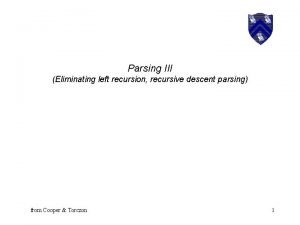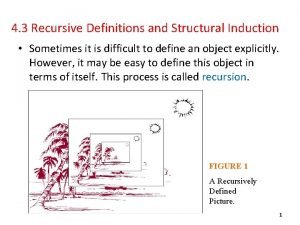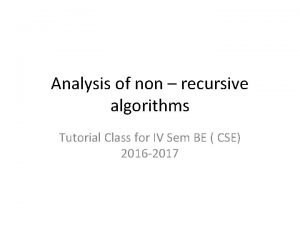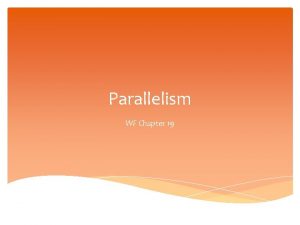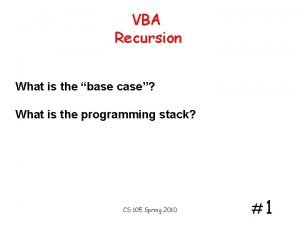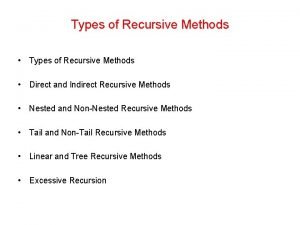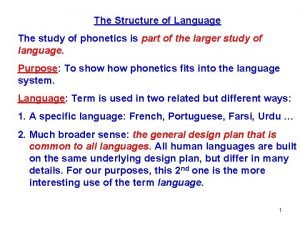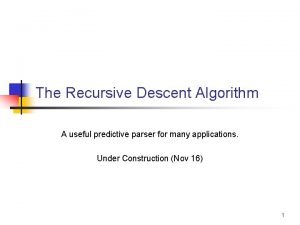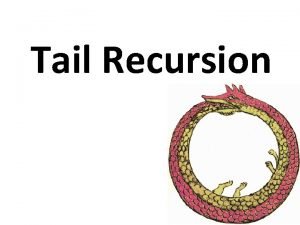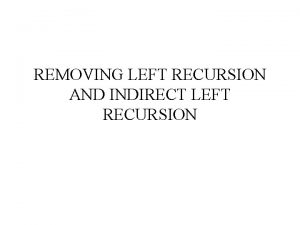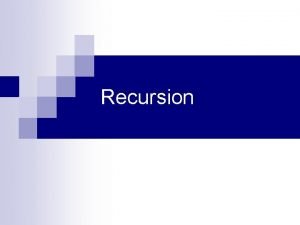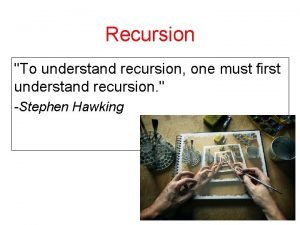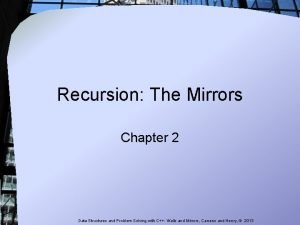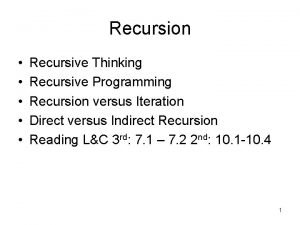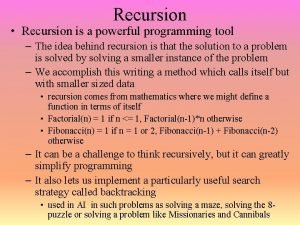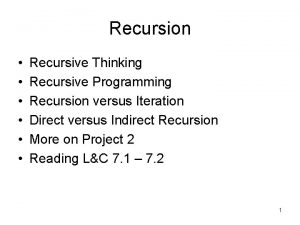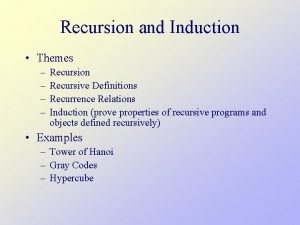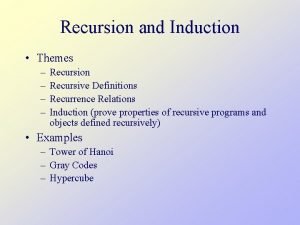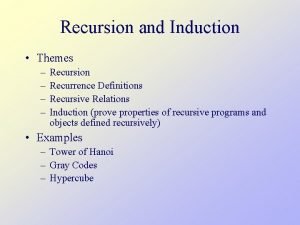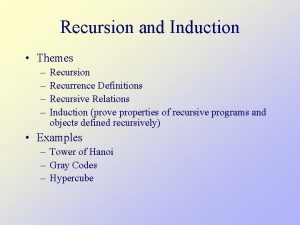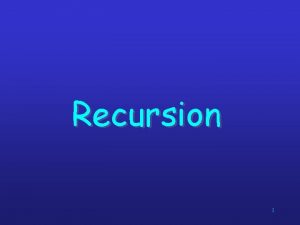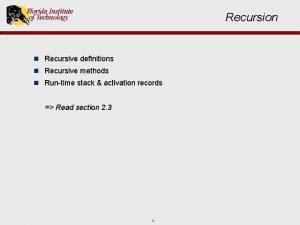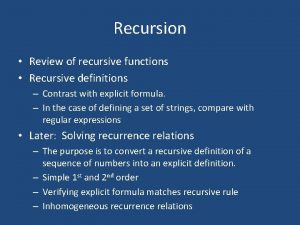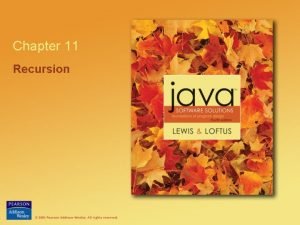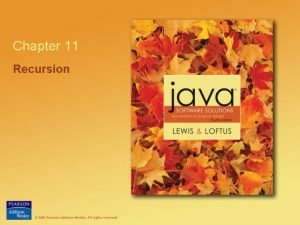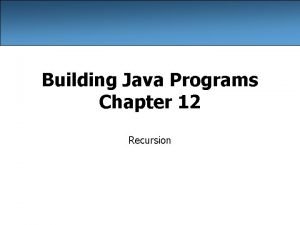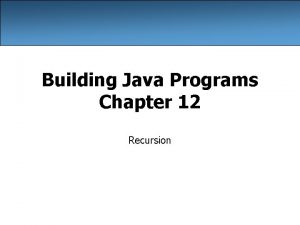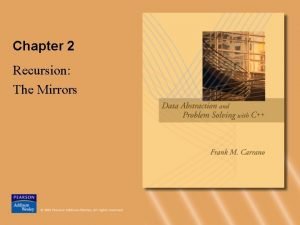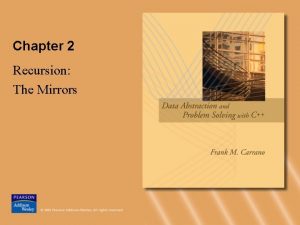Recursive Definitions Chapter 4 2 Recursive Definitions Recursion

















- Slides: 17

Recursive Definitions Chapter 4. 2

Recursive Definitions • Recursion is a principle closely related to mathematical induction. • In a recursive definition, an object is defined in terms of itself. • We can recursively define sequences, functions and sets.

Recursively Defined Sequences • Example: • The sequence {an} of powers of 2 is given by an = 2 n for n = 0, 1, 2, …. • The same sequence can also be defined recursively: • a 0 = 1 • an+1 = 2 an for n = 0, 1, 2, … • Obviously, induction and recursion are similar principles.

Recursively Defined Functions • We can use the following method to define a function with the natural numbers as its domain: 1. Specify the value of the function at zero. 2. Give a rule for finding its value at any integer from its values at smaller integers. • Such a definition is called recursive or inductive definition.

Recursively Defined Functions • Example: • f(0) = 3 • f(n + 1) = 2 f(n) + 3 • f(0) = 3 • f(1) = 2 f(0) + 3 = 2 3 + 3 = 9 • f(2) = 2 f(1) + 3 = 2 9 + 3 = 21 • f(3) = 2 f(2) + 3 = 2 21 + 3 = 45 • f(4) = 2 f(3) + 3 = 2 45 + 3 = 93




Recursively Defined Functions • How can we recursively define the factorial function f(n) = n! ? • f(0) = 1 • f(n + 1) = (n + 1)f(n) • f(0) = 1 • f(1) = 1 f(0) = 1 1 = 1 • f(2) = 2 f(1) = 2 1 = 2 • f(3) = 3 f(2) = 3 2 = 6 • f(4) = 4 f(3) = 4 6 = 24

Recursively Defined Functions • A famous example: The Fibonacci numbers • f(0) = 0, f(1) = 1 • f(n) = f(n – 1) + f(n - 2) • f(0) = 0 • f(1) = 1 • f(2) = f(1) + f(0) = 1 + 0 = 1 • f(3) = f(2) + f(1) = 1 + 1 = 2 • f(4) = f(3) + f(2) = 2 + 1 = 3 • f(5) = f(4) + f(3) = 3 + 2 = 5 • f(6) = f(5) + f(4) = 5 + 3 = 8

Recursively Defined Sets • If we want to recursively define a set, we need to provide two things: • an initial set of elements, • rules for the construction of additional elements from elements in the set. • Example: Let S be recursively defined by: • 3 S • (x + y) S if (x S) and (y S) • S is the set of positive integers divisible by 3.

Recursively Defined Sets • Proof: • Let A be the set of all positive integers divisible by 3. • To show that A = S, we must show that A S and S A. • Part I: To prove that A S, we must show that every positive integer divisible by 3 is in S. • We will use mathematical induction to show this.

Recursively Defined Sets • Let P(n) be the statement “ 3 n belongs to S”. • Basis step: P(1) is true, because 3 is in S. • Inductive step: To show: If P(n) is true, then P(n + 1) is true. • Assume 3 n is in S. Since 3 n is in S and 3 is in S, it follows from the recursive definition of S that 3 n + 3 = 3(n + 1) is also in S. • Conclusion of Part I: A S.

Recursively Defined Sets • Part II: To show: S A. • Basis step: To show: All initial elements of S are in A. 3 is in A. True. • Inductive step: To show: (x + y) is in A whenever x and y are in S. • If x and y are both in A, it follows that 3 | x and 3 | y. It follows that 3 | (x + y). • Conclusion of Part II: S A. • Overall conclusion: A = S.

Recursively Defined Sets • Another example: • The well-formed formulae of variables, numerals and operators from {+, -, *, /, ^} are defined by: • x is a well-formed formula if x is a numeral or variable. • (f + g), (f – g), (f * g), (f / g), (f ^ g) are well-formed formulae if f and g are. 15

Recursively Defined Sets • With this definition, we can construct formulae such as: • (x – y) • ((z / 3) – (6 + 5)) • ((z / (2 * 4)) – (6 + 5))

Practice Problems (4. 2) • 1, 6, 11, 16, 17
 To understand recursion you must understand recursion
To understand recursion you must understand recursion Eliminating left recursion
Eliminating left recursion Recursive definitions and structural induction
Recursive definitions and structural induction Non recursive algorithm
Non recursive algorithm Chapter 19 matching words with definitions
Chapter 19 matching words with definitions Improving vocabulary skills 5th edition
Improving vocabulary skills 5th edition Vba recursion
Vba recursion Using recursion in models and decision making
Using recursion in models and decision making Indirect recursion
Indirect recursion Example of phonology
Example of phonology Recursive descent parser calculator java
Recursive descent parser calculator java Tail recursion nedir
Tail recursion nedir Removing indirect left recursion
Removing indirect left recursion Recursion error fanfic
Recursion error fanfic Iteration vs recursion
Iteration vs recursion Box trace recursion
Box trace recursion Recursive definition examples
Recursive definition examples What is recursion can be a powerful tool for solving?
What is recursion can be a powerful tool for solving?

